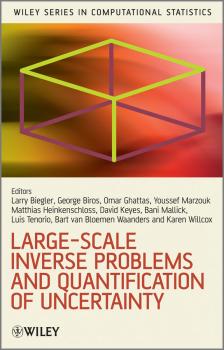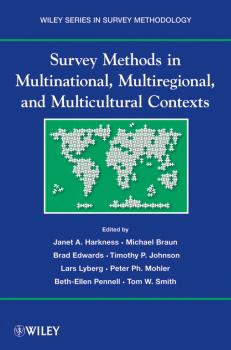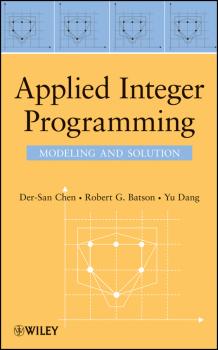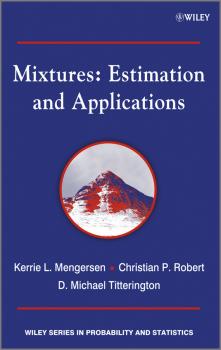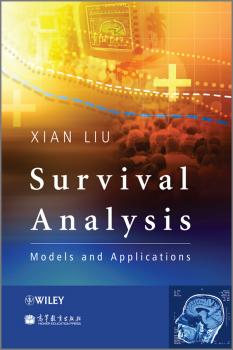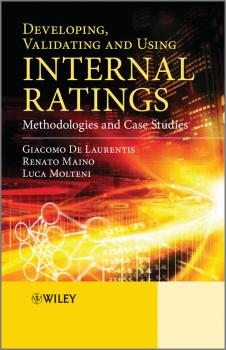ТОП просматриваемых книг сайта:
Математика
Различные книги в жанре Математика, доступные для чтения и скачиванияАннотация
This book focuses on computational methods for large-scale statistical inverse problems and provides an introduction to statistical Bayesian and frequentist methodologies. Recent research advances for approximation methods are discussed, along with Kalman filtering methods and optimization-based approaches to solving inverse problems. The aim is to cross-fertilize the perspectives of researchers in the areas of data assimilation, statistics, large-scale optimization, applied and computational mathematics, high performance computing, and cutting-edge applications. The solution to large-scale inverse problems critically depends on methods to reduce computational cost. Recent research approaches tackle this challenge in a variety of different ways. Many of the computational frameworks highlighted in this book build upon state-of-the-art methods for simulation of the forward problem, such as, fast Partial Differential Equation (PDE) solvers, reduced-order models and emulators of the forward problem, stochastic spectral approximations, and ensemble-based approximations, as well as exploiting the machinery for large-scale deterministic optimization through adjoint and other sensitivity analysis methods. Key Features: • Brings together the perspectives of researchers in areas of inverse problems and data assimilation. • Assesses the current state-of-the-art and identify needs and opportunities for future research. • Focuses on the computational methods used to analyze and simulate inverse problems. • Written by leading experts of inverse problems and uncertainty quantification. Graduate students and researchers working in statistics, mathematics and engineering will benefit from this book.
Аннотация
A unique collaboration featuring the latest methodologies and research on multi- and cross-national surveys Over the past two decades, the relevance of cross-national and cross-cultural methodologies has heightened across various fields of study. Responding to increasing cultural diversity and rapid changes in how research is conducted, Survey Methods in Multinational, Multiregional, and Multicultural Contexts addresses the need for refined tools and improved procedures in cross-cultural and cross-national studies worldwide. Based on research submitted to the International Conference on Multinational, Multicultural, and Multiregional Survey Methods (3MC), this book identifies important changes in comparative methodology approaches, outlines new findings, and provides insight into future developments in the field. Some of the world's leading survey researchers gather in this volume to address the need for a standard framework that promotes quality assurance and quality control in survey research, and its impact on various stages of the survey life cycle, including study design and organization, cross-national sampling, testing and pretesting, data collection, and input and output variable harmonization. Self-contained chapters feature coverage of various topics, such as: Question and questionnaire design, from both global and study-specific perspectives The construction and evaluation of survey translations and instrument adaptations The effects of cultural difference on the perception of question and response categories Non-response issues Analysis in comparative contexts, featuring discussion of polytomous item response theory, categorization problems, and Multi-Trait-Multi-Methods (MTMM) The significance of evolving methodologies for current international survey programs, including the European Social Survey, the International Social Survey Programme, and the Gallup World Poll Survey Methods in Multinational, Multiregional, and Multicultural Contexts is a valuable supplement for courses on comparative survey methods at the upper-undergraduate and graduate levels. It also serves as an insightful reference for professionals who design, implement, and analyze comparative research in the areas of business, public health, and the social and behavioral sciences.
Аннотация
An accessible treatment of the modeling and solution of integer programming problems, featuring modern applications and software In order to fully comprehend the algorithms associated with integer programming, it is important to understand not only how algorithms work, but also why they work. Applied Integer Programming features a unique emphasis on this point, focusing on problem modeling and solution using commercial software. Taking an application-oriented approach, this book addresses the art and science of mathematical modeling related to the mixed integer programming (MIP) framework and discusses the algorithms and associated practices that enable those models to be solved most efficiently. The book begins with coverage of successful applications, systematic modeling procedures, typical model types, transformation of non-MIP models, combinatorial optimization problem models, and automatic preprocessing to obtain a better formulation. Subsequent chapters present algebraic and geometric basic concepts of linear programming theory and network flows needed for understanding integer programming. Finally, the book concludes with classical and modern solution approaches as well as the key components for building an integrated software system capable of solving large-scale integer programming and combinatorial optimization problems. Throughout the book, the authors demonstrate essential concepts through numerous examples and figures. Each new concept or algorithm is accompanied by a numerical example, and, where applicable, graphics are used to draw together diverse problems or approaches into a unified whole. In addition, features of solution approaches found in today's commercial software are identified throughout the book. Thoroughly classroom-tested, Applied Integer Programming is an excellent book for integer programming courses at the upper-undergraduate and graduate levels. It also serves as a well-organized reference for professionals, software developers, and analysts who work in the fields of applied mathematics, computer science, operations research, management science, and engineering and use integer-programming techniques to model and solve real-world optimization problems.
Аннотация
This book uses the EM (expectation maximization) algorithm to simultaneously estimate the missing data and unknown parameter(s) associated with a data set. The parameters describe the component distributions of the mixture; the distributions may be continuous or discrete. The editors provide a complete account of the applications, mathematical structure and statistical analysis of finite mixture distributions along with MCMC computational methods, together with a range of detailed discussions covering the applications of the methods and features chapters from the leading experts on the subject. The applications are drawn from scientific discipline, including biostatistics, computer science, ecology and finance. This area of statistics is important to a range of disciplines, and its methodology attracts interest from researchers in the fields in which it can be applied.
Differential Equation Analysis in Biomedical Science and Engineering. Ordinary Differential Equation Applications with R - William Schiesser E.
Аннотация
Features a solid foundation of mathematical and computational tools to formulate and solve real-world ODE problems across various fields With a step-by-step approach to solving ordinary differential equations (ODEs), Differential Equation Analysis in Biomedical Science and Engineering: Ordinary Differential Equation Applications with R successfully applies computational techniques for solving real-world ODE problems that are found in a variety of fields, including chemistry, physics, biology, and physiology. The book provides readers with the necessary knowledge to reproduce and extend the computed numerical solutions and is a valuable resource for dealing with a broad class of linear and nonlinear ordinary differential equations. The author’s primary focus is on models expressed as systems of ODEs, which generally result by neglecting spatial effects so that the ODE dependent variables are uniform in space. Therefore, time is the independent variable in most applications of ODE systems. As such, the book emphasizes details of the numerical algorithms and how the solutions were computed. Featuring computer-based mathematical models for solving real-world problems in the biological and biomedical sciences and engineering, the book also includes: R routines to facilitate the immediate use of computation for solving differential equation problems without having to first learn the basic concepts of numerical analysis and programming for ODEs Models as systems of ODEs with explanations of the associated chemistry, physics, biology, and physiology as well as the algebraic equations used to calculate intermediate variables Numerical solutions of the presented model equations with a discussion of the important features of the solutions Aspects of general ODE computation through various biomolecular science and engineering applications Differential Equation Analysis in Biomedical Science and Engineering: Ordinary Differential Equation Applications with R is an excellent reference for researchers, scientists, clinicians, medical researchers, engineers, statisticians, epidemiologists, and pharmacokineticists who are interested in both clinical applications and interpretation of experimental data with mathematical models in order to efficiently solve the associated differential equations. The book is also useful as a textbook for graduate-level courses in mathematics, biomedical science and engineering, biology, biophysics, biochemistry, medicine, and engineering.
Аннотация
Causality in a Social World introduces innovative new statistical research and strategies for investigating moderated intervention effects, mediated intervention effects, and spill-over effects using experimental or quasi-experimental data. The book uses potential outcomes to define causal effects, explains and evaluates identification assumptions using application examples, and compares innovative statistical strategies with conventional analysis methods. Whilst highlighting the crucial role of good research design and the evaluation of assumptions required for identifying causal effects in the context of each application, the author demonstrates that improved statistical procedures will greatly enhance the empirical study of causal relationship theory. Applications focus on interventions designed to improve outcomes for participants who are embedded in social settings, including families, classrooms, schools, neighbourhoods, and workplaces.
Аннотация
Survival analysis concerns sequential occurrences of events governed by probabilistic laws. Recent decades have witnessed many applications of survival analysis in various disciplines. This book introduces both classic survival models and theories along with newly developed techniques. Readers will learn how to perform analysis of survival data by following numerous empirical illustrations in SAS. Survival Analysis: Models and Applications: Presents basic techniques before leading onto some of the most advanced topics in survival analysis. Assumes only a minimal knowledge of SAS whilst enabling more experienced users to learn new techniques of data input and manipulation. Provides numerous examples of SAS code to illustrate each of the methods, along with step-by-step instructions to perform each technique. Highlights the strengths and limitations of each technique covered. Covering a wide scope of survival techniques and methods, from the introductory to the advanced, this book can be used as a useful reference book for planners, researchers, and professors who are working in settings involving various lifetime events. Scientists interested in survival analysis should find it a useful guidebook for the incorporation of survival data and methods into their projects.
Introduction to Digital Systems. Modeling, Synthesis, and Simulation Using VHDL - Mohammed Ferdjallah
Аннотация
A unique guide to using both modeling and simulation in digital systems design Digital systems design requires rigorous modeling and simulation analysis that eliminates design risks and potential harm to users. Introduction to Digital Systems: Modeling, Synthesis, and Simulation Using VHDL introduces the application of modeling and synthesis in the effective design of digital systems and explains applicable analytical and computational methods. Through step-by-step explanations and numerous examples, the author equips readers with the tools needed to model, synthesize, and simulate digital principles using Very High Speed Integrated Circuit Hardware Description Language (VHDL) programming. Extensively classroom-tested to ensure a fluid presentation, this book provides a comprehensive overview of the topic by integrating theoretical principles, discrete mathematical models, computer simulations, and basic methods of analysis. Topical coverage includes: Digital systems modeling and simulation Integrated logic Boolean algebra and logic Logic function optimization Number systems Combinational logic VHDL design concepts Sequential and synchronous sequential logic Each chapter begins with learning objectives that outline key concepts that follow, and all discussions conclude with problem sets that allow readers to test their comprehension of the presented material. Throughout the book, VHDL sample codes are used to illustrate circuit design, providing guidance not only on how to learn and master VHDL programming, but also how to model and simulate digital circuits. Introduction to Digital Systems is an excellent book for courses in modeling and simulation, operations research, engineering, and computer science at the upper-undergraduate and graduate levels. The book also serves as a valuable resource for researchers and practitioners in the fields of operations research, mathematical modeling, simulation, electrical engineering, and computer science.
Solutions Manual to Accompany Classical Geometry. Euclidean, Transformational, Inversive, and Projective - I. Leonard E.
Аннотация
Solutions Manual to accompany Classical Geometry: Euclidean, Transformational, Inversive, and Projective Written by well-known mathematical problem solvers, Classical Geometry: Euclidean, Transformational, Inversive, and Projective features up-to-date and applicable coverage of the wide spectrum of geometry and aids readers in learning the art of logical reasoning, modeling, and proof. With its reader-friendly approach, this undergraduate text features self-contained topical coverage and provides a large selection of solved exercises to aid in reader comprehension. Material in this text can be tailored for a one-, two-, or three-semester sequence.
Аннотация
This book provides a thorough analysis of internal rating systems. Two case studies are devoted to building and validating statistical-based models for borrowers’ ratings, using SPSS-PASW and SAS statistical packages. Mainstream approaches to building and validating models for assigning counterpart ratings to small and medium enterprises are discussed, together with their implications on lending strategy. Key Features: • Presents an accessible framework for bank managers, students and quantitative analysts, combining strategic issues, management needs, regulatory requirements and statistical bases. • Discusses available methodologies to build, validate and use internal rate models. • Demonstrates how to use statistical packages for building statistical-based credit rating systems. • Evaluates sources of model risks and strategic risks when using statistical-based rating systems in lending. This book will prove to be of great value to bank managers, credit and loan officers, quantitative analysts and advanced students on credit risk management courses.

